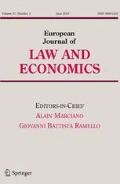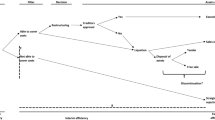Abstract
This article assesses the effect of a reduction in secured creditor priority on distributions and administrative costs in liquidating bankruptcy cases by reporting the first empirical study of the effect of a priority change. Priority reform had redistributive effects in liquidating bankruptcy. As expected, average payments to general unsecured creditors were significantly higher after the reform than before the reform and payments to secured creditors decreased. Reform did not increase the size of the pie to be distributed in bankruptcy. Nor did it increase the direct costs of bankruptcy.
Similar content being viewed by others
References
Adler, B. E. (1993). “An Equity-Agency Solution to the Bankruptcy-Priority Puzzle.” J. Legal Stud. 22, 73.
Ang, J. S., Chua, J. H., & McConnell, J. J. (1982). “The Administrative Costs of Corporate Bankruptcy: A Note.” J. Fin. 37, 219, 223–224.
Baird, D. G. (1992).The Elements of Bankruptcy, 14.
Baird, D. G. (1997). “The Importance of Priority.” Cornell L. Rev. 82, 1420.
Barclay, M. J. & Smith, C. W. Jr. (1995). “The Priority Structure of Corporate Liabilities.” J. Fin. 50, 899.
Bebchuk, L. A. & Fried, J. M. (1996). “The Uneasy Case for the Priority of Secured Claims in Bankruptcy.” Yale L.J. 105, 857.
Bebchuk, L. A. & Fried, J. M. (1997) “The Uneasy Case for the Priority of Secured Claims in Bankruptcy: Further Thoughts and a Reply to Critics.” Cornell L. Rev. 82, 1279, 1288.
Bergström, C., Eisenberg. T., & Sundgren, S. (2002). “Secured Debt and the Likelihood of Reorganization.” Int’l Rev. L and Econ. 21, 359, 360–361.
Bergström, C., Eisenberg, T., Sundgren, S. & Wells, M. T. (2005). “The Fate of Firms: Explaining Mergers and Bankruptcies.” J. Empirical Legal Stud. 2 (in press).
Bulow, J. I. & Shoven, J. B. (1978). “The Bankruptcy Decision.” Bell J. Econ. 9, 437.
Chen, S.-S., Yeo, G. H. H., & Ho, K. W. (1998). “Further Evidence on the Determinants of Secured Versus Unsecured Loans.” J. Business, Finance and Accounting, 25, 371.
Eisenberg, T. (1993). “Baseline Problems in Assessing Chapter 11.” U. Toronto L.J. 43, 633.
Eisenberg, T. & Sundgren, S. (1997). “Is Chapter 11 Too Favorable to Debtors?” Cornell L. Rev. 82, 1532, 1536.
Eisenberg, T. & Tagashira, S. (1994). “Should We Abolish Chapter 11? The Evidence from Japan.” J. Legal Stud. 23, 111.
Fisher, T. C. G. & Martel, J. (1999). “Should We Abolish Chapter 11? Evidence from Canada.” J. Legal Stud. 28, 233.
Hansmann, H. & Kraakman, R. (1991). “Toward Unlimited Shareholder Liability for Corporate Torts.” Yale L.J. 100, 1879, 1902.
Harris, S. L. & Mooney, C. W. (1997). “Measuring the Social Costs and Benefits and Identifying the Victims of Subordinating Security Interests in Bankruptcy.” Cornell L. Rev. 82, 1349, 1356.
Havansi, E. (1991). Suomen Konkurssioikeus, 369.
Hill, C. (2002). “Is Secured Debt Efficient?” Texas L. Rev. 80, 1117.
Hudson, J. (1995). “The Case Against Secured Lending.” Internat’l Rev. Law & Econ. 15, 47.
Jackson, T. H. & Kronman, A. T. (1979). “Secured Financing and Priorities Among Creditors.” Yale L.J. 88, 1143, 1158–1161.
Jensen, M. C. & Meckling, W. H. (1976). “Theory of the Firm: Managerial Behavior, Agency Costs and Ownership Structure.” J. Fin. Econ. 3, 305.
Kanda, H. & Levmore, S. (1994). “Explaining Creditor Priorities,” Virginia L. Rev. 80, 2103.
Klee, K. N. (1997). “Barbarians at the Trough: Riposte in Defense of the Warren Carve-Out Proposal.” Cornell L. Rev. 82, 1466, 1472–1474.
Kordana, K. A. & Posner, E. A. (1999). “A Positive Theory of Chapter 11.” N.Y.U.L. Rev. 74, 161, 213.
Leebron, D. W. (1991). “Limited Liability, Tort Victims and Creditors.” Colum. L. Rev. 91, 1565.
Leeth, J. D. & Scott, J. A. (1989) “The Incidence of Secured Debt: Evidence from the Small Business Community.” J. Fin. and Quantitative Analysis. 24, 379.
Lopucki, L. M. & Doherty, J. W. (2004). “The Determinants of Professional Fees in Large Bankruptcy Cases.” J. Empirical Legal Stud. 1, 111.
Maddala, G. S. (1989).Introduction to Econometrics, pp. 283–290.
Mann, R. J. (1997a). “Explaining the Pattern of Secured Debt.” Harv. L. Rev. 110, 625.
Mann, R. J. (1997b). “The Role of Secured Credit in Small-Business Lending.” Georgetown L.J. 86, 1.
Rajak, H., Horrocks, P., & Bannister, J. (1995).Corporate Insolvency Law in the United Kingdom, in European Corporate Insolvency: A Practical Guide, 2nd edition pp. 725, 734–736, 741–742, 768.
Ravid, A. S. & Sundgren, S. (1998). “The Comparative Efficiency of Small-Firm Bankruptcies: A Study of the U.S. and Finnish Bankruptcy Codes.” Financial Management. 27, 28.
Schwartz, A. (1981). “Security Interests and Bankruptcy Priorities: A Review of Current Theories.” J. Legal Stud. 10, 1.
Schwartz, A. (1984). “The Continuing Puzzle of Secured Debt.” Vanderbilt L. Rev. 37, 1051, 1054.
Schwartz, A. (1997). “Priority Contracts and Priority in Bankruptcy.” Cornell L. Rev. 82, 1396, 1398.
Scott, R. E. (1986). “A Relational Theory of Secured Financing.” Columbia L. Rev. 86(21), 901, 906.
Shleifer, A. & Vishny, R. W. (1992). “Liquidation Values and Debt Capacity: A Market Equilibrium Approach.” J. Fin. 67, 1343.
Shupack, P. M. (1989). “Solving the Puzzle of Secured Transactions.” Rutgers L. Rev. 41, 1067, 1088.
Smith, C. W. & Warner, J. B. (1979). “On Finance Contracting, An Analysis of Bond Covenants,” J. Fin. Econ. 7, 117.
Stiglitz, J. & Weiss, A. (1981). “Credit Rationing in Markets with Imperfect Information.” Am. Econ. Rev. 71, 393.
Stulz, R. & Johnson, H. (1985). “An Analysis of Secured Debt,” J. Fin. 14, 501.
Sundgren, S. (1998). “Does a Reorganization Law Improve the Efficiency of the Insolvency Law? The Finnish Experience.” Europ. J. Law and Econ. 6, 177, 193.
Sundgren, S. (1999). Qualified Audit Opinions, Audit Quality and the Likelihood of Bankruptcy, in IV Law and Business Risks, Accepted Papers at The Third International Stockholm Seminar on Risk Behaviour and Risk Management 73, 78.
The Right of Priority Committee (Huvudbetänkande av Förmansrättskommittén), New Priority Rules (Nya Förmansrättsregler) (SOU (Statens offentliga utredningar) 1999:1) 40–41.
Thorburn, K. S. (2000). “Bankruptcy Auctions: Costs, Debt Recovery, and Firm Survival.” J. Fin. Econ. 58, 337.
Triantis, G. G. (1992). “Secured Debt Under Conditions of Imperfect Information.” J. Legal Stud. 21, 225, 227.
United Savings Assoc’n of Texas v. Timbers of Inwood Forest, Ltd. (1988) 484 U.S. 365.
Warner, J. (1977). “Bankruptcy Costs: Some Evidence.” J. Fin. 32, 337, 345.
Warren, E. (1997). “Making Policy with Imperfect Information: The Article 9 Full Priority Debates.” Cornell L. Rev. 82, 1373, 1374.
Weiss, L. A. (1990). “Bankruptcy Resolution: Direct Costs and Violation of Priority Claims.” J. Fin. Econ. 27, 285.
Webb, D. C. (1991). “An Economic Evaluation of Insolvency Procedures in the United Kingdom: Does the 1986 Insolvency Act Satisfy the Creditors’ Bargain?” Oxford Economic Papers. 43, 139.
White, M. (1980). “Public Policy Toward Bankruptcy.” Bell J. Econ. 11, 550.
White, J. J. (1984). “Efficiency Justifications for Personal Property Security.” Vanderbilt L. Rev. 37, 473, 491–502.
Yearbook of Justice Statistics Statistics Finland, Justice (1998), 4, 348.
Author information
Authors and Affiliations
Corresponding author
Additional information
JEL Classification: K00, K20, G33
Rights and permissions
About this article
Cite this article
Bergström, C., Eisenberg, T. & Sundgren, S. On the Design of Efficient Priority Rules for Secured Creditors: Empirical Evidence from A Change in Law. Eur J Law Econ 18, 273–297 (2004). https://doi.org/10.1007/s10657-004-4274-1
Issue Date:
DOI: https://doi.org/10.1007/s10657-004-4274-1




